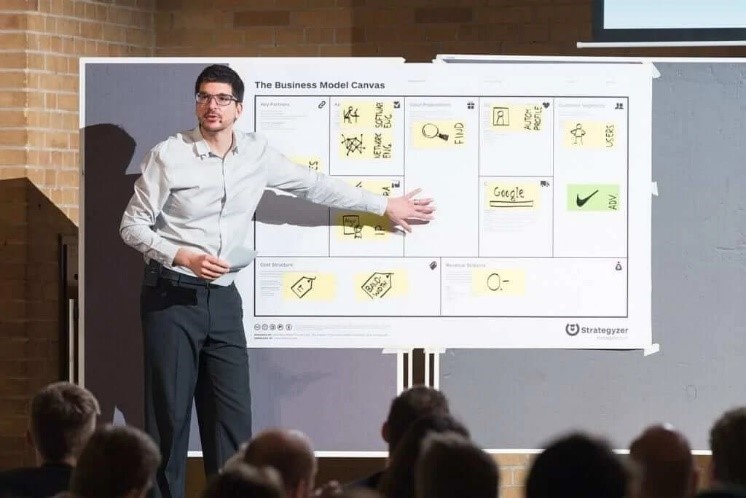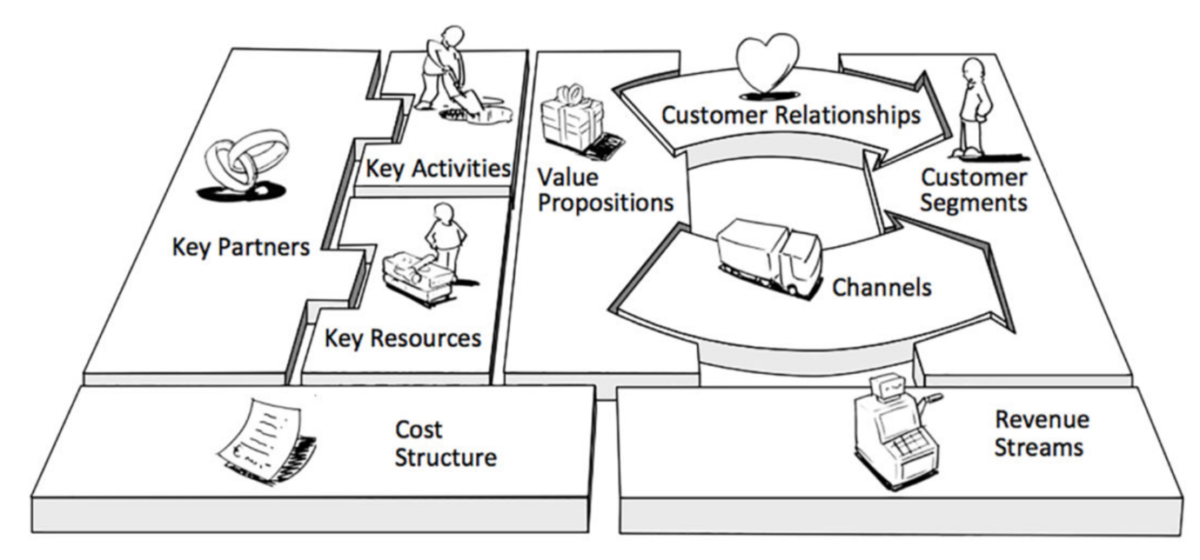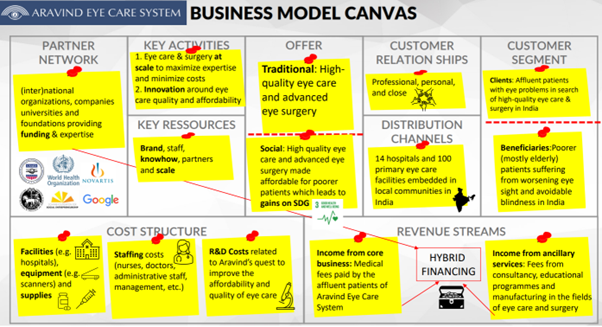Introduction
In today’s rapidly evolving business landscape, entrepreneurs are increasingly recognizing the importance of incorporating social and environmental goals into their ventures. Social entrepreneurship, a growing field that focuses on creating sustainable solutions to societal problems, requires a unique approach to business planning — the Business Model Canvas.

Since we here at SteepConsult are supportive of social entrepreneurs everywhere, we decided to put our heads together and use our own experience in this field to see what knowledge we could share with all current and prospective social entrepreneurs who are out there looking for knowledge to improve their chances at success.
Today, we shall be writing about a tool that is very useful for any social entrepreneur who wants to launch a new initiative or find ways to explain their social enterprise in a straightforward and striking visual manner to lay people.
This tool has already gained widespread popularity in a normal for-profit context, as it is an extremely effective representation of business ontology. We are talking of course about the popular Business Model Canvas (BMC).
This particular tool is so popular because it allows entrepreneurs to effectively summarize their business and present it in a visually appealing manner to people without much understanding of their specific business. This is important because as another popular fake Einstein quote – as we did to introduce you to the concept of what is a VRIO analysis – so aptly states:
Most probably not Einstein“’If you can’t explain it to a six-year-old, you don’t understand it yourself”1
While the veracity of this claim is something you should take with more than a grain of salt, it does reflect an important tenet of human psychology. People will not invest in you, nor will they buy your product or else be interested in working with or for you if you cannot clearly explain to them what your business is all about.
To help clarify your business idea and ensure that you are able to pitch it properly to third parties, the BMC is an ideal tool to help you focus. Important to know for social entrepreneurs in particular is that the BMC that is used in a social entrepreneurial setting does however sport a few slight differences to the classic format designed by Alexander Osterwalder and Yves Pigneur in 2005. We shall highlight these in the sections to come and show you how to make proper use of the differences.
This article will study the application of the BMC in a social entrepreneurial context, highlight its benefits and provide practical insights for professionals in this space who are aiming to create impactful ventures.
Understanding the Business Model Canvas
The Business Model Canvas, developed by Alexander Osterwalder and Yves Pigneur, is a strategic management tool that helps entrepreneurs visually depict and analyse the key components of their business model. It consists of the following nine building blocks, each of which we have clarified with a small explanation:
Customer Segments
You can not be everything to everyone. The key to success is focus. By zooming in on the nexus of unique pain points, demographics, buyer behaviour, and other relevant characteristics, you should be able to segment your potential audience and identify those segments where the chance of success is the greatest.
Value proposition
As with the customer segments, your value proposition should also focus on the key decision-making features in your industry. On these key features, you should be able to define why your product or service is better than its competitors (e.g., it’s cheaper, more user-friendly, higher in quality, more robust, more sustainable, etc.).
Channels
Which distribution channels are you going to use to bring your product/service to your customers. This can be a network of brick-and-mortar locations, a webstore, social media, etc.
Customer Relationships
This aspect of the BMC is focussed on the interaction with customers and is highly contingent on the exact type of business you are.
Revenue streams
In this aspect of the BMC, an entrepreneur is asked to detail how their business is going to make money. This seems a rather straightforward question at first glance, but it can soon start to become quite complex. A prime example on this front is Amazon.
If we simplify Amazon’s business model, it is a web shop and it makes its money through the buying and selling of goods. However, Amazon generates massive reams of data due to the popularity of its product. This data is also monetized through online advertisement options that are fed by the data it gathers on its customers.
On top of that, to host all the data produced by their web platform, Amazon became an early investor in cloud computing which led to the rise of AWS, which monetizes the expertise Amazon has built in cloud computing.
Key Activities
Here, we have to return to our value proposition and ask how we plan to achieve it. It is in other words a question of toolkits. Will you offer superior service by hiring more people? Will you offer cheaper services by investing heavily in automation?
Key resources
This section lists every resource that enables you to organize your key activities and thus make good on your value proposition. This could be staff members with specific expertise, IP, brand value, material assets such as factories, capital, etc.
Key Partnerships
This section of the BMC lists those stakeholders (e.g., your suppliers, customers, mentors, trade associations, etc.) which might enable you to succeed.
Cost structure
This section should be completed with an overview of all the key cost drivers, as well as try to categorize them (fixed v. variable, emphasis on capital or labour expenditures, etc.).
Filling the business model canvas
Below we have included a rather valuable schematic overview of the various aspects of the BMC. We like this view primarily because it does a great job in mapping the dynamism of this framework:

A common mistake when completing out the BMC is that not enough attention is paid to the interplay between the nine key components. It is however a fact that you cannot really look at one part of the BMC in isolation if you truly want to fulfil its promise. The sign of mastery lies in the fact that you can explain how the cost structures allows you to hire/maintain key resources, which allow you to organize your key activities and thus deliver on your value proposition.
While we will see in just a bit that the BMC is preferably filled out from right to left, which allows you to move from the questions that are most visible to your clients to the back-end processes which support it, once it is completed you should be able to jump from one section of the BMC to the other and see the logical connections in between the different areas.
As mentioned before, the BMC was initially designed for traditional businesses. However, its adaptability and flexibility make it highly relevant for social entrepreneurs as well. Naturally, the structural set up of a traditional BMC is completely geared towards the ontological components of a traditional for-profit business structure and all the peculiarities that this entails.
As we shall examine in the next chapter, the traditional BMC structure has been slightly tweaked at various points to capture the reality as experienced by social entrepreneurial ventures.
Adapting the Business Model Canvas for Social Entrepreneurship
When applying the BMC to a social entrepreneurial context, certain modifications and considerations are necessary. Let’s explore how each building block can be approached in the context of social entrepreneurship:
Customer Segments
In the social entrepreneurship realm, the “customer segments” portion of the BMC becomes a little bit more complicated. For these types of ventures, a split is often introduced between clients on the one hand and beneficiaries on the other hand (although not always).
This split is particularly necessary in cases of cross-financing, where a service or product is sold to for-profit customers to finance the service or product offered to beneficiaries. Roughly speaking, we might say that the beneficiaries are the reason for the social project, while the clients are more impacted by the core entrepreneurial drive.
In any case, identifying the needs, preferences, and challenges of both beneficiaries and targets is crucial to create a relevant value proposition.
Value proposition of offer
Social entrepreneurs must articulate their unique value proposition, which addresses both social and economic or traditional benefits. We prefer to describe this as the “Offer” to differentiate it from the more limited scope of a value proposition in the for-profit BMC. To bring a good “Offer” description to the table, you need to identify the social problem that your venture addresses, the solution being offered, and the value it creates for beneficiaries, partners, and funders.
Channels
Effective communication and distribution channels are also vital for social entrepreneurs. They need to consider the most appropriate methods to reach their target audience, ensuring the delivery of their products, services, or interventions effectively.
Customer Relationships
In social entrepreneurship, building strong relationships with beneficiaries, partners, and stakeholders is fundamental. This often requires a deep understanding of community dynamics and an empathetic approach to foster trust and collaboration.
Revenue Streams
Generating revenue is a crucial aspect of any sustainable venture. Social entrepreneurs need to consider diverse revenue models that align with their mission, such as impact investments, grants, cross-subsidization, or earned income strategies.
Key activities
Social entrepreneurs engage in a range of activities to create social impact. This includes research, product or service development, community engagement, advocacy, and policy work. Identifying and prioritizing key activities is essential for efficient resource allocation.
Key Resources
In addition to financial and human resources, social entrepreneurs must consider the intellectual, social, and natural resources required to deliver their intended impact. Leveraging partnerships, volunteer networks, and shared resources can enhance their operational capacity.
Key Partnerships
Collaboration is often vital for social entrepreneurs, who often work with diverse stakeholders, such as non-profits, governments, corporations, and community organizations. Forming strategic alliances can broaden the reach, expertise, and impact of a social enterprise.
Cost structure
Analysing the cost structure helps social entrepreneurs ensure financial sustainability. They must consider direct costs, overheads, and investments required to deliver their impact while maintaining a balance between social objectives and economic viability.
Benefits of Using the Business Model Canvas for Social Entrepreneurs
The adoption of the BMC by social entrepreneurs offers several advantages, we have already introduced a few of these in our introduction, but we shall quickly reiterate all the arguments in favour of using the BMC below:
Visual Clarity:
The BMC provides a clear and visual overview of the entire business model. This allows social entrepreneurs to:
- Identify potential gaps, synergies, and areas for improvement.
- Pitch their business in convincing and authoritative manner to customers, investors, and other potential partners
Iterative Approach:
The BMC allows for easy experimentation and iteration, enabling social entrepreneurs to refine their model over time. As a living document, it is great to expose to successive generations of employees/partners/beneficiaries/other stakeholders so that it can be constantly refined. In this manner, the BMC is a low-effort way of engaging in Open Innovation (on which we have quite coincidentally written the definitive guide, available here).
Applying the Business Model Canvas to a real-life Use Case
As we here at SteepConsult like to get our hands dirty, we thought it would be a good idea to put our knowledge into practice and apply the social entrepreneurial BMC to a social venture that we ourselves greatly admire for its results.
Aravind Eye Care System is a pioneering healthcare organization in India that focuses on providing high-quality, affordable eye care services. Founded by Dr. G. Venkataswamy in 1976, Aravind Eye Care System aims to eliminate needless blindness by making eye care accessible to all sections of society, particularly the underprivileged.
Aravind’s innovative approach includes a unique cross-subsidy model, where revenue from paying patients is utilized to offer free or subsidized services to those who cannot afford them. This model enables the organization to reach a diverse range of patients and ensure that quality eye care is available to all, regardless of their socio-economic background.
With this model, Aravind has been able to expand tremendously. Not only has it performed about 7.8 million operations over the course of its operations, but its impact has also expanded from its original Indian heartlands to countries all over the developing world due to its training programmes and manufacturing prowess (with a focus on creating low-cost and affordable eye care tools for Low-and Middle-Income countries around the world).
We have completed a BMC for Aravind Eye Care System and included it here for teaching purposes below. We have tried to make it as simple as possible, using post-it like visuals as a call back to the way it is ideally filled in during a collective exercise with an experienced facilitator like those, we have at SteepConsult. The logos are there to make it visually a bit more striking and the arrows are there for the benefit of the reader to showcase the relationship between the various aspects of the BMC:

Now let us go through this BMC example in a step-by-step approach. As mentioned earlier, when starting from an empty canvas, it is generally recommended to begin with the client-facing parts of the BMC first.
Offer
We would recommend beginning with the ‘Offer’ first, as your value proposition is what drives everything else in your project. As stated before, in a social entrepreneurial venture, the question of the offer is rather more complicated than in a normal for-profit context in the sense that you can have both a traditional and a social offer.
In case of Aravind, the division is relatively uncomplicated, since it offers the same type of services (i.e., high-quality eye care) to both its paying clients and its subsidized beneficiaries. The difference is that the former have to pay market rates for the therapies they consume, while the beneficiaries are helped at rates that are far below standard market prices. Note that such an uncomplicated division is not necessarily the standard.
It is perfectly possible for a social enterprise to offer one type of service or product to paying clients and do something completely different to help its beneficiaries. The benefits of the Aravind approach, however, are quite attractive since offering the same service/product in the traditional and social offer allows you to realize economies of scale that would not be present otherwise.
In the case of Aravind in particular, this is vital as a lot of eye surgery is (perhaps somewhat counter-intuitively) rather sensitive to scale. Thus, Aravind’s surgeons get a lot of practice from working on their poor patients, which ups the standard of care they can offer to their paying customers. Since the quality of their offering is higher, Aravind’s paying customers are prepared to lay out greater sums for their treatment at Aravind’s facilities. Thus, the paying patients cross-subsidize Aravind’s offer to its beneficiaries.
On top of that, further savings are achieved by combining the two patient flows, lowering the costs per treatment. Due to the lower cost per treatment, Aravind’s profit margins on its paying customers are higher and the expenses for offering treatments to poor beneficiaries are lowered. The interplay between all these various advantages thus creates a virtuous circle that benefits everyone serviced by Aravind.
Customer Segment
Our explanation of the Offer above already does quite a bit to explain the customer segmentation in place at Aravind. Like with the Offer, there is a division between the clients (i.e., the same group of people who would be present in a for-profit BMC) and the beneficiaries (i.e., the newly introduced group of people who benefit from the ‘social’ side of the project).
In this section, we shall therefore just restrict ourselves to adding a bit more context. For starters, we wrote in our previous section that eye care surgeries lend themselves to scale quite well. This is primarily visible in the high number of people Aravind treats for avoidable blindness. The most common cause of which are age-related cataracts. Since blindness has such a tremendous impact on the daily life of patients in developing countries (e.g., by preventing them to work or take care of their families, despite being otherwise healthy), it is hugely cost-effective to prevent/cure any cases of blindness that are as easy to fix as cataracts. Since this old age disease affects both the rich and the poor similarly, it is easy to go and hunt for the economies of scale Aravind’s model requires.
As to paying clients, here we would like to stress the fact that people who could afford this type of treatment in the past would often have to go abroad to seek treatment. Despite the fact that for many of these richer patients, the additional expense this caused was not necessarily a dealbreaker, the benefits of finding proper care close to home are self-evident. It is therefore easy to see why richer patients would have a strong incentive to make use of Aravind’s local services.
Customer relationships
On the relationship front, there is relatively little difference between the traditional and social offer at Aravind. As this is a medical relationship in both cases, it is important that interactions with beneficiaries/clients are professional.
As we shall see in the next section of distribution channels, Aravind has also built out an expansive infrastructure of primary care facilities. These focus on preventative treatments and aftercare for the people who had to undergo a surgical intervention. To ensure that people come in regularly, it is important for Aravind’s staff members to strive for a personal and close relationship with both groups serviced by themselves.
Distribution channels
To facilitate the type of care that is necessary to fulfil its mission, Aravind has to be present in close proximity to the final users. That is why they have built an extensive network of over a hundred primary eye care treatment centres embedded in local communities and these centres in turn serve as a funnel to bring the patients who need surgery to the network of 14 hospitals which Aravind has set up to bring this type of capital-intensive surgery to the masses it serves.
Key Activities
As to Aravind’s key activities, we can also be rather brief. The original idea that animated Aravind was to bring affordable eye care to the masses. In the beginning, its sole focus was on carrying out the actual treatments.
Once they had optimized their model and were able to benefit from the economies of scale we have described in our section on their Offer, Aravind started to have room to broaden its scope. It has thus started innovation activities in the broader field of eye care surgery with a focus on reducing costs.
If you are interested in more information on expanding your core offering with exploratory activities which can over time become new drivers of business, feel free to reach out to SteepConsult. Our consultants are specialized in the use of StrategyTools diagrams, which allow for a structured and efficient estimation of future business opportunities. [To be added in a box, with a link to information on ST, to be checked with Quentin if there is already something on StrategyTools available on our website]
This has led to training programmes to spread knowledge on the one hand, and innovation about the cost-effectiveness of eye care surgery equipment and treatment on the other hand. Since most of the leading providers of this type of equipment/medicine/treatment focus on western markets were the need to be cost-effective is less pronounced, Aravind’s focus on affordability has allowed it to emerge as one of the few providers of (relatively) low-cost treatment options, broadening its positive impact to include most of the developing world.
The know-how that as a result of these activities has accrued to Aravind has furthermore strengthened their position, as it has allowed them to recoup the costs of its innovations by bringing them to an even wider audience than the one Aravind traditionally services in India alone.
Key Resources
On Aravind’s key resources, we can again be brief. The biggest advantage it currently has is its scale, this has allowed it to build up deep know-how through the employment of skilled staff. This has allowed it to further improve its brand profile and has led to a virtuous circle of partnerships.
Partner Network
Aravind, as a successful social venture of considerable scale, has over the years been able to set up wide-ranging partnerships with various international organisations, multi-national enterprises, and government agencies (see logos on the BMC for some examples).
A successful social enterprise can be an attractive partner for all three groups, since association with the social venture will lend a halo-effect to the organisations it partners with. A particular strength of an organization that is as big as Aravind is that it can be a more logical counterpart for the colossal type of organizations like the UN or a company like Google who seek to use some of their resources for the benefit of all. For these organizations, a social venture that is of a sufficient scale has a gravitational pull all of its own as it unburdens for example Google from having to keep track of many different ventures individually.
Revenue Streams
From the partner networks, we seamlessly flow into the revenue streams. In the case of Aravind, it is very clearly an example of hybrid financing. Hybrid financing means that the organisations is not dependent on donations and grants only.
Aravind does receive some financial supports from its wide partner network (explaining the red arrow that runs from partner networks to revenue streams), but most of the income comes from two other sources, namely its core service offering and its ancillary services.
The income from its core activities is the revenue generated by Aravind’s core offering to its paying clients. The income from ancillary services is all the income they derive from their training programmes, R&D activities and the manufacturing of core surgical tools, medicine and other equipment needed to provide high-quality eye care and surgery.
Cost Structure
The cost structure of Aravind is relatively uncomplicated. It primarily boils down to three major blocks. First, there are the costs related to staffing. To maintain a large and expansive network, Aravind needs good employees (mostly highly trained doctors and nurses). This of course requires competitive salaries and other benefits, which given the size of the workforce does amount to a pretty number.
Secondly, there are the costs related to maintaining its facilities. Both the primary eye care centres and the hospitals are expensive to maintain, so that also soaks up a lot of costs. Finally, there are all the costs associated to the ancillary activities of Aravind. Production facilities and the development of courses all require expenditure and together this is the third block of the cost structure.
Conclusion
In the realm of social entrepreneurship, where the pursuit of social and environmental impact is paramount, the Business Model Canvas (BMC) serves as a valuable tool for planning and strategizing. By adapting the BMC to suit the unique needs of social entrepreneurs, professionals in this field can effectively design and execute ventures that address pressing societal challenges.
Furthermore, the BMC’s visual nature offers a clear and concise representation of the entire business model, allowing social entrepreneurs to identify areas for improvement, innovation, and collaboration.
By utilizing the BMC, social entrepreneurs can effectively communicate their ideas, attract stakeholders, secure funding, and measure their progress towards achieving their social mission. Moreover, the canvas facilitates strategic decision-making, resource allocation, and the identification of key partnerships necessary for maximizing impact.
It is important to note that the BMC is not a static tool but a dynamic one that should be revisited and adapted as the social enterprise evolves. Social entrepreneurs must remain agile, open to feedback, and willing to iterate their business models to stay relevant and effective in the future.

Innovation & Change Consultant
Our Author
After having amassed a wealth of experience in Innovation & Change Management, Arjan joined SteepConsult to support our transition towards an innovative, solution-oriented, and sustainable future. As our in-house intellectual, he enjoys sharing his knowledge with customers and colleagues alike.
Reference List
Hoos, F. (2017). Social Entrepreneurship and Changemaking: From Traditional to Social Entrepreneurial Business Model Development [Course Presentation]. Innovation Management & Entrepreneurship University Certificate, HEC Paris.
Marbaise, M. (2017). The Business Model Canvas Let Your Business Thrive with this Simple Model. AA 50Minutes.
Orgler, M. (2021, May 18). How to Fill in the Business Model Canvas? – Business to the Moon – Medium. Medium. Retrieved from https://medium.com/business-to-the-moon/how-to-fill-in-the-business-model-canvas-590e200a13da


